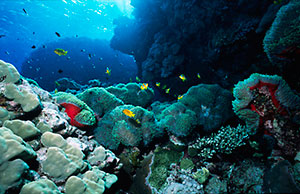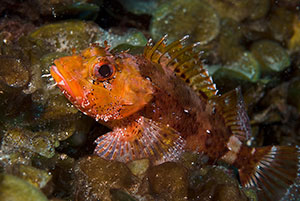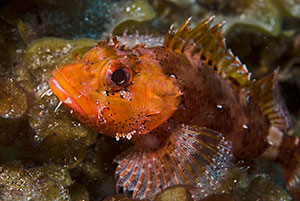Really close you see lovely textures and details, patterns,
and abstract designs
|
|

|
You don’t have to always get close, but here the whole scene is important, not just the fish. So it is more difficult to find a view where everything will work together.
|
Bottom dwelling, almost stationary, subjects. It’s easy to photograph a frogfish, and the art often lies more in finding it in the first place. But with something that sits still you have the chance to move around it and make the most of the best angle.
|
|

|
MOVE IN GRADUALLY
Even slow-moving fish can be skittish if you go in straight at them. Approach fish very slowly without any sudden movements, until you are close enough to get a reasonable shot.When I approach a fish I often swim in an arc rather than straight to it, and don’t look directly at it. |
Move closer if you can. If the fish starts to get uncomfortable, pause and maybe back off a bit. Learn to recognise its body language - twitches of fins and eye movements are signs that it is about to swim off.
|

|
|
The more careful and patient you are the more likely you will be rewarded. Take your time, but don’t waste too long on a hopeless case.
|
Learn to recognise which species are likely to be approachable. But be aware that individuals of the same species may behave differently. Make the most of co-operative ones like this inquisitive Napoleon wrasse at Ras Mohammed.
|
|
|
LOOK FOR CLEANING STATIONS
Cleaning stations are a feature of coral reefs, and are great places to take photographs. There are plenty of fishes hanging around, and they are less bothered by your presence while they are preoccupied with being cleaned.
|
Even a shy fish may stay around, giving the chance to take a series of shots.
|
|